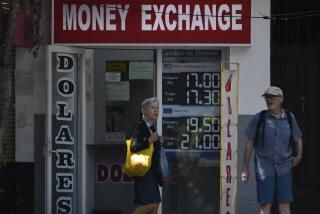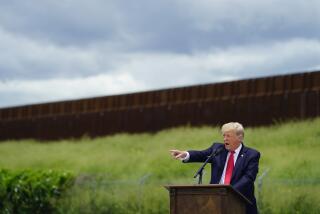Economic Reforms Help Latin America Ease Its Debt Crisis
Latin America may, at last, be showing the first signs of emerging from its debt crisis, which poured red ink onto U.S. banks in the late 1980s and created a crisis of confidence in Latin economies.
After a 17-month hiatus, Brazil--Latin America’s largest debtor nation--announced earlier this month that it would resume interest payments on the $60 billion it owes private banks early next year. Meanwhile, the World Bank said in a new report that the debt crisis facing developing countries is “somewhat less severe.”
Banking officials and other experts say they are heartened by economic changes that have enabled countries such as Venezuela, Mexico and Uruguay to successfully reschedule some of their huge debt this year and get on sounder financial footing. That, in turn, offers a bit of brightness for American banks in an increasingly gloomy business environment.
However, analysts caution that Latin America’s progress could be jeopardized by a U.S. recession as well as sharply higher oil prices.
“The big story is that these economies are opening up,” said Kenneth Hoffman, a vice president who heads the international finance department at the New York brokerage Shearson Lehman Hutton. “Everybody is hoping that this constant round of reschedulings is finally over.”
In one significant vote of confidence, Moody’s Investors Service Inc. earlier this month gave Mexico’s foreign currency debt its highest rating for a Latin American country. Although Moody’s Ba-2 rating for Mexico’s $95 billion of foreign currency debt is below investment grade, the ratings agency said the relatively positive appraisal reflects Mexico’s success at economic reform.
The same day, Peru and the International Monetary Fund agreed on broad guidelines for economic reforms, clearing the way for new loans.
Peruvian officials now hope that the United States, Japan and some European and Latin American countries will provide low-interest loans and grants totaling $2.5 billion during the next year to cover a balance-of-payments gap and to clear back-due interest that piled up during former President Alan Garcia’s administration.
Through the past decade, Western bankers and Latin American finance ministers have debated how to retire the region’s estimated $428-billion foreign debt, built up during a long orgy of lending and spending, and exacerbated by waste and corruption.
The principal weapon employed to attack the debt problem recently has been the so-called Brady initiative, named for U.S. Treasury Secretary Nicholas F. Brady and launched in March, 1989.
Under the Brady plan, commercial banks agree to forgive part of the money they are owed by a foreign borrower or to reduce the interest rates charged. In exchange, the remainder of the loans to the developing nation are effectively guaranteed by the International Monetary Fund, the World Bank and the industrialized nations that support those organizations.
Brady-style loan rescheduling pacts, initially pooh-poohed by many analysts, have been arranged with increasing frequency in recent months.
Earlier this month, Venezuela rescheduled some of its $34.4 billion in foreign debt. Earlier this month, commercial lenders agreed to reschedule about $1.69 billion in loans to Uruguay. Chile and Costa Rica have also signed debt agreements, and Ecuador and Argentina are holding discussions with their banks.
Although some experts say the approach gives indebted nations much needed breathing room, there continues to be widespread frustration with the tactic among Latin Americans. Residents complain that Brady agreements force their governments to extend painful austerity measures under which they have been suffering for years, without helping rebuild Latin economies.
Moreover, for U.S. bankers, rearranging payment schedules neither erases debt nor makes up for losses.
“The fact is that the majority of the countries are not servicing their debt. They are still in arrears,” said Robert Devlin, a senior economist in the Santiago office of the United Nations Economic Commission for Latin America. “Those arrears are reflective of the deficiencies in the debt strategy.”
Indeed, the same World Bank report that saw glimmers of hope in the developing nations’ debt picture noted that those countries’ collective debt continued to grow in 1990, climbing 6% to $1.34 trillion.
But skepticism in some parts of the U.S. financial community is apparently beginning to subside as economic reforms take hold in portions of Latin America.
Although experts point out that each country’s financial plight is unique, overall America has become “cautiously optimistic” about many of its southern neighbors, said Mark Constantine, an aide to the House Banking Committee’s international development, finance, trade and monetary policy subcommittee.
Why? In recent years, a number of Latin American nations have dropped trade barriers, instituted economic reforms and adopted more realistic foreign currency exchange rates to improve their economies, Constantine explained.
Four countries--Bolivia, Colombia, Peru and Venezuela--agreed in November to eliminate tariffs and open a free-trade zone to foreign capital by the end of 1991. Meanwhile, Argentina, Brazil, Paraguay and Uruguay plan to establish a common market by 1995.
That sort of economic liberalization may do more to help Latin America recover from a decade of troubles than any debt relief plan, World Bank officials say.
Officials are particularly hopeful for major oil exporting countries such as Venezuela and Mexico. John Reed, chairman of New York’s Citicorp--the biggest U.S. bank and the one with the most loans to Latin America--recently told an audience in Mexico City: “Debt is not an issue in Mexico” any longer for international banks.
That upbeat assessment, however, is tempered by tough times in many nations in the region--especially Brazil, Peru and Argentina, where hyper-inflation remains a persistent worry. What’s more, a United Nations study reported last week that just three of 24 Latin American nations studied--Costa Rica, Venezuela and Colombia--had positive economic growth rates this year.
Although Brazil’s announcement that it will resume interest payments to private banks may be seen as good news by some, virtually all analysts said the economic plight of Latin America’s largest nation remains dire. Few believe that Brazil can keep up interest payments without significant infusions of foreign capital.
Despite the lack of growth, lenders and investors are hanging tough.
“Many countries in the region are taking positive steps to privatize (their industries) and . . . integrate their economies,” said William Orme, editor of Latin Finance, a Miami-based publication that covers the field. “There’s more optimism now.”
Latin America’s Biggest Debtors Total loans owned by the five Latin American nations with the biggest debts to U.S. banks, as of June 30, 1990 Brazil: $12,462.8 Mexico: $8,712.7 Venezuela: $3,883.4 Chile: $647.4 Colombia: $131.7 Source: Veribanc Inc.
More to Read
Sign up for Essential California
The most important California stories and recommendations in your inbox every morning.
You may occasionally receive promotional content from the Los Angeles Times.










